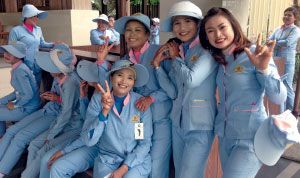Southeast Asia’s complicated caddy program

The caddies in Southeast Asia are primarily women. They are professional, knowledgeable and upbeat.
Having lunch with superintendents and club managers in Thailand and Malaysia is not much different than lunch with their counterparts here in the United States. Small talk is on agronomic issues, golf and golfers — all at an enthusiastic level. However, for me, one topic that I could not resist bringing up was the women caddies.
The Southeast Asia golf courses that I was at this past summer and in past years had a large number of women caddies. There are male caddies, but they were in the minority at the clubs I visited. The caddies (male or female) did not physically carry the bags; they either pulled/pushed the bag using a trolley, or drove/rode the golf cart. Watching the women caddies, I was impressed with their professionalism and golf knowledge — like where to properly stand on the tee, fairway or green, their ability to help provide distance and proper club selection, cleaning a golf ball and, when asked, reading a putt. The caddies were always smiling and upbeat. It was like ordering a coffee at Starbucks.
So at lunch I asked a couple of the club managers about the women caddy programs. These gentlemen told me that some clubs actually recruit caddies from Indonesia or other countries in Southeast Asia. Many of the girls come from poor to extremely impoverished backgrounds. They know little, if anything, about golf.
Once at the golf course, the caddies enter intensive training programs learning about golf and golf etiquette — proper safety for the golfer, enhancing pace of play and practices that maintain the quality of the golf course.
The golf courses provide the caddies with payment during the training period and also restrict their movement on and off the property. In one case, the caddies were only allowed to leave the golf club’s premises one day a week, between the hours of 10 a.m. and 7 p.m.
One of the reasons given for restricting the women to the premises initially was to reduce the likelihood of losing some of them to prostitution, which is prevalent in the region.
As the women begin caddying and generating money for the golf club and themselves through tips, life changes for many of these women. Often you see a few of these caddies with iPhones and iPads, a sign of upward mobility. At the very least, caddying has provided a means to help escape abject poverty for some of these women and their families.
Golf is not going to solve the world’s ills; nor do I suspect every Southeast Asia golf course’s women caddy program are like the ones described to me. But if you can change the life of one person or 70 at one golf course, is that not something worthwhile?
As I was leaving and walked past the club’s caddy stand, I couldn’t help but think about the heyday of caddy programs here in the United States and the impact those programs had on the lives of so many young people — including me.
Photo: Karl Danneberger








